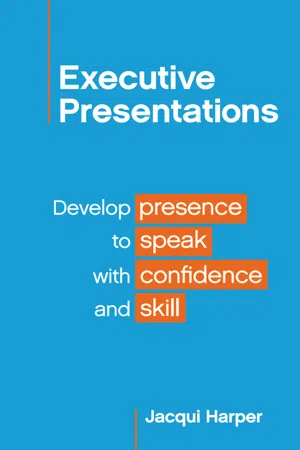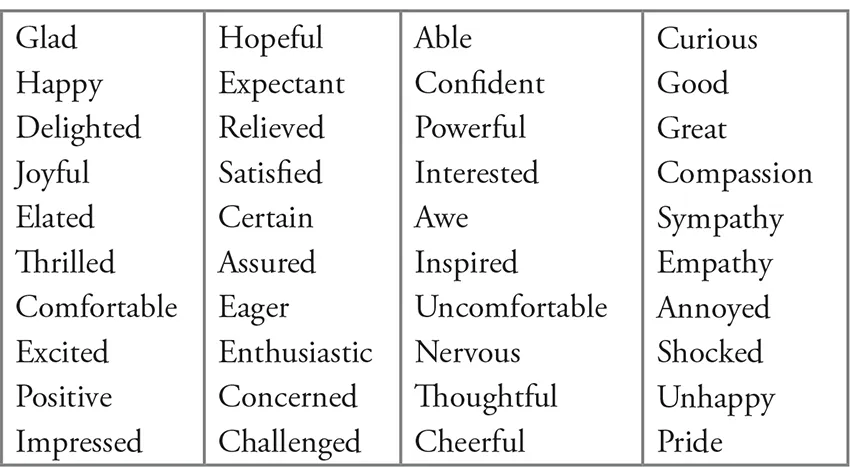![]()
Chapter 1
BEGIN POWERFULLY
BEGIN A PRESENTATION powerfully and you have a huge advantage. A weak start on the other hand can be very hard to turn around. This chapter is about achieving that advantage with effective ways to connect quickly and deeply to an audience.
This chapter is also the first of five on making the most of your message. I’ve created a tool called BRIBE to help you communicate clear and compelling ideas. BRIBE is an easy-to-remember acronym and each letter represents a topic covered in this and subsequent chapters. The acronym is explained below.
BRIBE model
B = Begin Powerfully
R = Reinforce Ideas
I = Involve the Audience
B = Be Bold
E = End Powerfully
Preview
This chapter shows four ways to make the strongest start to an executive presentation:
• The emotional objective
• The information objective
• The preview
• The Hook
The emotional objective
I’ve learned that people will forget what you said, people will forget what you did, but people will never forget how you made them feel.
Maya Angelou1
Executive speakers would do well to follow the wise words of writer Maya Angelou. Instead, too often people start preparing a presentation by focusing on the objective. This usually means the information objective of the presentation: the point or ideas they want the audience to take away.
The information objective is important but I would encourage a slightly different starting point. If Maya Angelou is right and ultimately what’s remembered is how you make an audience feel, then start with the emotional objective. By that I mean think about what you want the audience to feel when you’ve finished speaking. Do you want them to feel excited, uncomfortable, comfortable, reassured, curious, reflective, encouraged? Be clear about the precise emotional response you want to elicit.
Alongside this, consider ways to evoke those emotions. At your disposal are the words you choose, storytelling, the structure of the presentation, the themes, the slide deck, your voice, body language, facial expressions and your appearance. All these points are discussed throughout this book. Points about content are covered in chapters on the BRIBE model. There’s more information on how to use your body to communicate your message on page 87.
The focus on working with an emotional objective can help create a deep connection with an audience. It establishes the kind of rapport that makes an audience more likely to want to listen to what you have to say.
This technique of using emotional objectives in public speaking has been around since ancient times. The Greek philosopher Aristotle is a well-known exponent of it. In his book The Art of Rhetoric he identifies three tools for effective speech: argument, character and emotion. When speaking in public, Aristotle says:
One should lead the listener to emotions. These are pity and indignation, anger and hatred and envy, jealousy and strife.2
Later in this chapter, on page 22, we return to Aristotle’s ideas on public speaking.
Today, many would identify slightly different fundamental human emotions: happiness, sadness, fear, anger, surprise, disgust and trust. It is certainly possible to use some of these emotions in executive presentations but it feels a bit limiting to me. When I am speaking at conferences I like to have more nuanced emotional objectives available to me so I turn to feelings, sometimes called compounds of emotions.3
When teaching at INSEAD I often show participants a chart listing human feelings and I encourage them to select the feeling(s) most relevant to the executive presentation they are creating. I remind them that there is one feeling relevant to all presentations: trust. See Figure 1 for others.
Figure 1: List of human feelings
Without doubt the most effective way of achieving emotional objectives in presentations is through storytelling. Our brains just love stories. A good story activates many parts of the brain, releases oxytocin, makes us more empathic and more co-operative. Go to page 160 for insights on telling good stories in business meetings.4
Mapping emotions
Some people find it useful to have one overarching emotional objective for an entire presentation. Others like the idea of mapping specific emotional objectives to different parts of the presentation. For example, you might want surprise at the beginning of a presentation; reassurance in the middle; and excitement as the emotional objective at the end.
Figure 2 shows an emotional map of a lecture I give on executive presence. It shows the emotions I’m focused on and the ways I choose to generate them. As an exercise, I often ask participants to scrutinise my opening speech to them and identify the emotional objectives. Thankfully, they’ve always identified the emotions I intended!
Element of presentation | Emotional objective | Ways to generate the emotions |
Beginning | Trust | Tell them a short story of my lifelong love affair with communication – to understand my expertise and passion for the subject. |
Beginning | Enthusiasm | Smile and speak with vocal energy, facial animation and gestures. |
Middle | Thoughtful | Give the audience new ways to think about the structure of a presentation by sharing the BRIBE model. |
Middle | Thoughtful | Ask questions – both real and rhetorical. |
Middle | Surprise | Use unexpected examples to illustrate ideas. For example, I sometimes show a short video of international rapper Kanye West accepting a music award because it is an exceptional example of how to end a speech. There’s more discussion of this example on page 58. |
End | Inspiration | Close class with an inspiring quote. One of my favourites is an extract from the inaugural speech of the late Nelson Mandela. He in turn borrowed it from American writer and women’s advocate, Marianne Williamson. It talks beautifully about letting go of fear and owning your power and talent. I never tire of reading it. Go to the link to read in full. www.goodreads.com/quotes/928-our-deepest-fear-is-not-that-we-are-inadequate-our |
Figure 2: Mapping emotional objectives
The information objective or WIIFM
We move from discussing the emotional objective to the information objective. I have been using WIIFM (pronounced ‘wiff-mm’) for so long that I cannot remember where I first came across it. It simply stands for What’s In It For Me. The ‘me’ in this instance is the audience not the speaker.
This is about audience advocacy. It’s about putting yourself into the minds of an audience. It’s about giving an audience a clear understanding of what they will gain from your presentation and why it is so relevant to them. They need to know they will get something of high value in return for giving you their time and attention.
I encourage you to be explicit about the WIIFM and to deliver it within three or so minutes of starting a presentation. This timing can be extended slightly if you are speaking for a longer period of time – but not by much. If you take too long making clear what’s in it for the audience, you risk them disengaging from your speech while they figure out for themselves what’s in it for them. In the early moments of a presentation it is instinctive to wonder where a speaker is going: if that curiosity is satisfied in good time it’s a...

